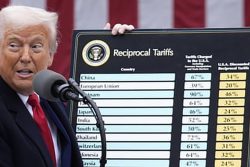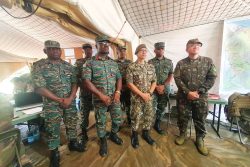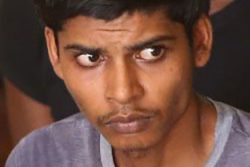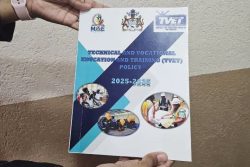I’ve mentioned before that we don’t need to wade through reams of data or voluminous comparisons to reach some basic conclusions on seemingly complex matters; that we can often get a clear and almost instantaneous insight on these issues from indicators staring us in the face.
There is, for example, frequent debate about Guyana’s current economic state with historical arguments pro and con, and a variety of opinion, with several different axes being resolutely ground. Opinions differ; clarity suffers. And then in the space of two days, if we’re paying attention, we get a quick insight into how far the Guyana economy has come; we notice a very impressive modern hardware store, Fixit, smack in the heart of Main Street.
 From the automatic sliding door as you enter, to the spacious aisles inside, with items clearly displayed, and courteous sales staff, one could be excused for the feeling that he/she is in an overseas environment. The change from Fixit’s former Kingston location is simply striking.
From the automatic sliding door as you enter, to the spacious aisles inside, with items clearly displayed, and courteous sales staff, one could be excused for the feeling that he/she is in an overseas environment. The change from Fixit’s former Kingston location is simply striking.
In that same week, in another insight, we see that Georgetown now boasts another impressive development in the appearance of the Rosignol Butcher Shop. You enter the place, and you cannot believe your eyes. This is no “butcher shop” in the sense of the vernacular term.
Stepping into this new operation on Church Street is to be in the kind of spacious deli or meat store you would find in Toronto or New York, with a wide variety of fresh meats, attractively displayed, as to type and price (you don’t have to ask what they have; it’s staring at you), and a number of items simply not previously seen in our meat stores. The place is modern, well appointed, and user-friendly.
In these two developments one recognizes, almost like a flashed image, clear evidence how far our economy has progressed. Twenty-five years ago, probably even 12 years ago, those kinds of business barometers would have been unthinkable here.
There are other barometers of course – the explosion in housing communities such as the one at Diamond and two in West Demerara; the new vehicle numbers exhausting the alphabet on licence plates – but to notice these two in town, in the space of two days, one instantly gets the message of the significant growth in the economic muscle of Guyana; there is not only the emerging availability of such products, but, more significantly, the market now clearly exists for them. There are other examples, but here’s one more: the launch, also in this week, of a slick, four-colour magazine, Invest Guyana, produced by Lokesh Singh.
Its somewhat confusing logo aside, the magazine is a professional outreach to investors basing its approach on the country’s steady economic performance, particularly in the past 6 years, in the face of faltering economies elsewhere. Fifteen years ago, the notion of such a magazine would have approached absurdity; today it is an accepted plank for business here. It’s an indication of how far we’ve come that such a magazine is now viable.
In the same week, however, prodded by a long-time Caymanian friend, I logged onto the website of the television station there to see a series of interviews with politicians contesting the upcoming general election in that country. In a 6-part series, viewers saw an aggressive interviewer simultaneously engaging candidates from the three contesting groups, in a vigorous back and forth. In that exposure, one sees vividly how far we have to go in Guyana in such matters. In this age of instant comment and instant counter, we remain sadly backward in the matter of balanced media coverage.
Nowhere on our television screens can we see the kind of exchange that that small island in the northwest Caribbean is producing. Cayman is a place of only 55,000 people and 80 square miles – the entire country can fit in the mouth of the Essequibo with enough space left for the American Sixth Fleet – but compare their indigenous television performance to ours.
We continue to see in Guyana these absurd public affairs programmes where a party or a group, with one view, is pandered to (the concept of “interview” is farcical) by a moderator whose official purpose seems to be to let his/her guests dispense their positions unchallenged.
The irony is that Guyana is chock full of highly interesting, even pivotal topics (we all know them; I will spare you the list) and the public is keenly interested in these things. Why can’t we have the political heavyweights from our various units facing each other in reasoned discussion about matters that affect our lives?
Why can’t we have business people with contrasting views putting their cases before the public? Why aren’t we hearing various positions debated so that some measure of understanding might emerge?
Why are we consigned to listening to one view, delivered by high priests from that side, propelled by a host in the same robes, and watched only by members of that congregation? It has occurred to me that after these gatherings, someone should take up a collection.
Apart from joy among the brethren, nothing is being achieved there. Why does it prevail?
It’s worth noting that I have asked this question of well-known television hosts of all stripes, and in every case I get the same response. “We invite persons from the other side, but they won’t come.” The answer is revealing.
It tells us that in a time where, in the space of one week, we can see such developments as a first-rate hardware store, a high-end meat shop, and an impressive investment magazine, we are mired in the doldrums on public affairs across our broadcast media.
Perhaps the recent broadcast-facility expansion – ironically, itself a prime subject for the kind of televised debates we don’t have – can be seen as a sign of hope. The message here may not be spelled out in a newspaper article, but it is manifest. As we take note, and justifiably so, of how far we have come in one area, let us also take note of how far we have to go in another.









